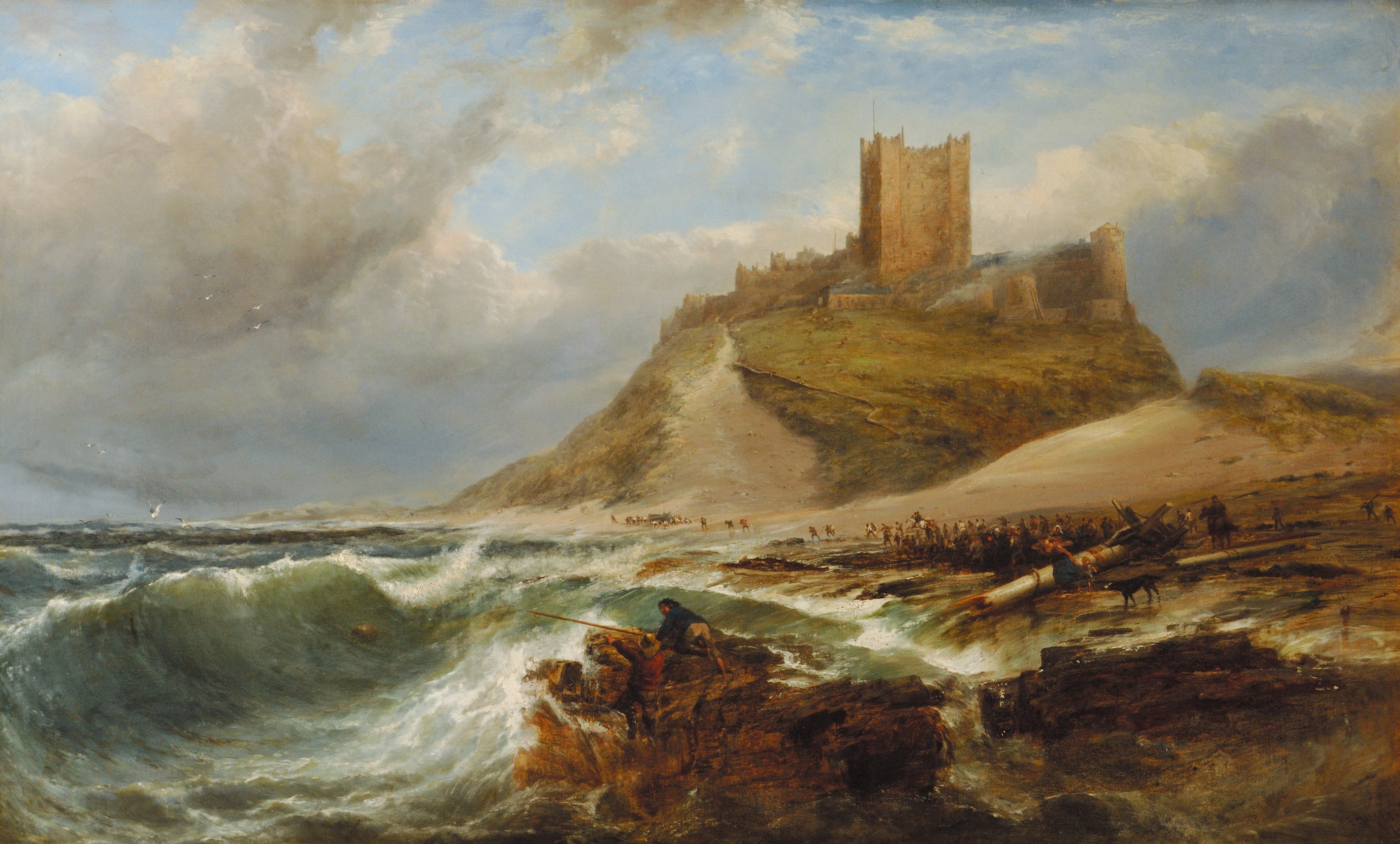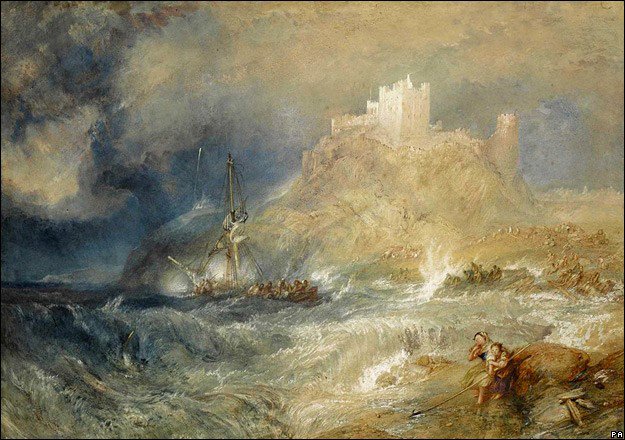28. Bamburgh Castle, Signal of Distress in the Offing, by Edwin Hayes
 Edwin Hayes (1819-1904), Bamburgh Castle, Signal of Distress in the Offing, 1866, oil on canvas.
Edwin Hayes (1819-1904), Bamburgh Castle, Signal of Distress in the Offing, 1866, oil on canvas.
In Edwin Hayes’s dramatic scene of the
Northumberland coast, the unmistakeable form of Bamburgh Castle rises into the
cloud, still and forbearing above the immediate foreground action in which
figures throng along the beach amidst pieces of a broken mast and other
detritus of a wrecked vessel. The lowered horizon, inherited from seventeenth-century
Dutch landscape and marine painting, enables this vertiginous topographical
view while simultaneously plunging the viewer into the turmoil of sea and
figures in the lower half of the composition. This work is typical of Hayes’s oeuvre, which
included seascapes in Ireland, England, Belgium, Holland, France, Spain, and
Italy, and which usually feature high seas, ships, harbours or coastlines.
The title is key to the way in which
this painting works. When the painting was acquired by Peter Hacker for the
college in 1986 from the Gamble Bequest (in fact a number of marine or naval
paintings were acquired through this), it was catalogued as Wreck off Bamburgh Castle. However,
there is evidence that Hayes exhibited this work in 1866 at the Society of
British Artists in London as Bamboro
Castle. A signal of Distress in the Sky, and a handwritten note made by
Professor Hacker at the time of the purchase records the current title: Bamburgh Castle, Signal of Distress in the
Offing. While there is certainly visual evidence to support the simple
title of a ‘wreck’, the other titles have a more interesting affect on the
narrative of the work. There is no visible signal of distress in the painting
so what we are looking becomes the immediate aftermath or consequence of such a
signal – added to by the circling seagulls whose presence might be read as
indicating the origin of the wreckage or disaster. The current title, ‘in the
offing’ is more compelling than the vaguer ‘in the sky’: ‘offing’ means ‘the
more distant part of the sea in view’ so that the title brings together a more
precise visual location of the site of distress with the imminence of the
common use of the phrase ‘in the offing’ to give the viewer a sense of cause and
effect captured within the scene. It is a good example of the way in which a
single image can bind various temporalities within itself. Something has happened, is happening, and
will happen. What we see is neither the disaster itself nor fully the beached
wreckage – instead we are given action that sits between these loci.
The crowd are salvagers, possibly
rescuers, and certainly spectators. And on the rocks in the immediate
foreground are two figures, one reaching with a rod or stick to draw in more
pieces of assumed wreck and the other pointing out to sea. Kneeling on a raised
rock being battered by waves and with their backs to the viewer, these figures
frame the scene positioning the viewer at their level, and effectively closing
the composition into a circle that between the beach, the castle and their
backs forces the viewer’s gaze to rise from the space between the offing and
the waves crashing on the beach to the castle and the open sky. Although we
might read the contrast between the still castle sitting in a windy but bright
sky and the sense of disaster and action on the beach as another contrast
between time frames – the castle that has stood against history and weather for
1400 years (shown in this view from the north side it is the Norman walls of
the castle that are most prominent), and the immediate fragility of a wrecked
ship at the mercy of the rocks and water – the contrast here also risks the
composition fragmenting into two disconnected parts.
This potential disconnection is not
uncommon in such mid-century seascapes or landscapes that seek to combine
action with topography. The influence of J.M.W. Turner is clear, but where for Turner
composition and light wholly towards atmospheric effect, this kind of emotive
unity is lost in Hayes. In 1797, Turner made drawings of
Bamburgh Castle in his North of England
Sketchbook, and these, plus a watercolour dating from the 1830s (see below)
suggest that Turner might have been a direct source for Hayes’s composition. In
Turner’s painting, in which watercolour has been applied almost more thickly
and certainly with more animation than Hayes’s use of oil, the castle is viewed
from the same northern aspect and we see the same hurrying figures on the
shore, albeit less distinct. And on the rock in the foreground two figures,
possibly children, look out to sea clutching a long pole and behind them are
several splintered pieces of wood.

J.M.W. Turner (1775-1851), Bamburgh Castle, 1830s, watercolour.
Turner’s interest in depicting the
destructive power of nature is clear here, not only in the brush marks that
emulate the swirling water and clouds, but also in the way that the dark sea
breaking to luminous surf is echoed in the sky which moves from a deep blue
towards a threatening orange. The castle glows, unreal, emerging as a
foreboding ghostly presence above the maelstrom below. Turner’s painting in
this period is the apotheosis of English Romanticism; intense psychological
affect drawn out of this atmospheric engagement with nature. What remains of
this in Hayes’s work is largely the placing of the viewer below and within the
scene – our positioning is precarious and it works to make the viewer confront
rocks and sea before all else. But Hayes also returns to a more controlled
narration, the presence of imminent danger and alarm in this painting is not
achieved by an assault on the senses but is accrued by the scene as it unfolds
across the composition.
View the painting on Art UK here.
 Dr Jennifer Johnson, Junior Research Fellow in History of Art
Dr Jennifer Johnson, Junior Research Fellow in History of Art